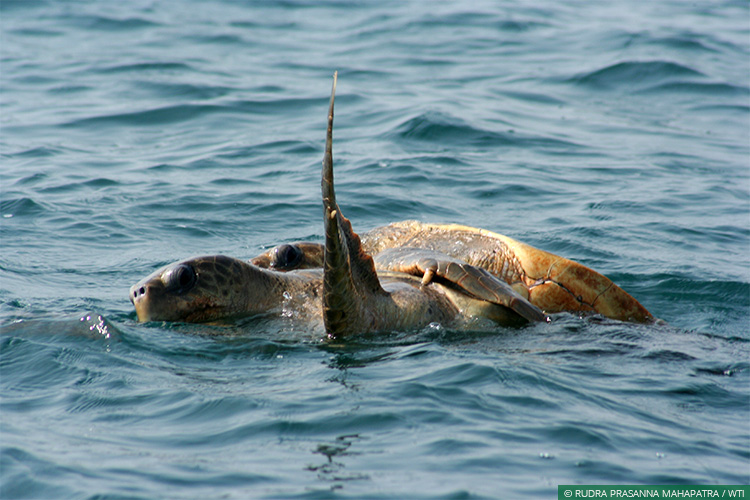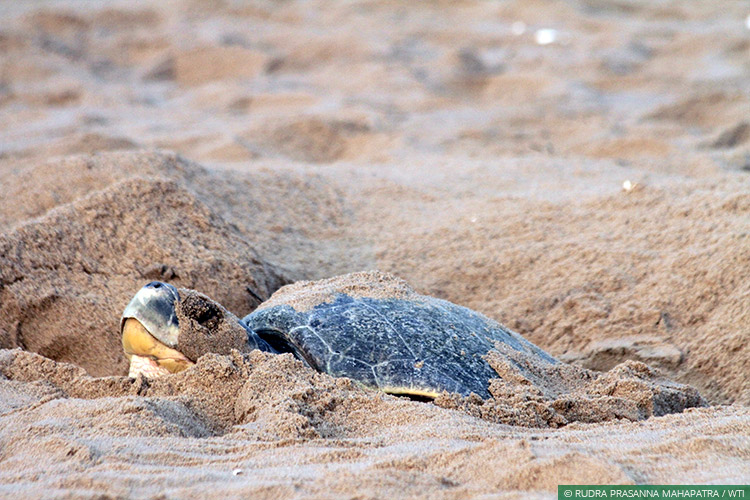By Rudra Prasanna Mahapatra

A pair of olive ridley sea turtles mating off the coast of Odisha
As the first table tennis ball-shaped egg dropped onto the sand, a year-long wait came to an end. Yes, it was the beginning of a new life cycle, one that I was there to witness at Gokharkuda beach near the Rushikulya river mouth in Odisha. As the eminent American biologist Lynn Margulis once said: “Life on earth is such a good story you cannot afford to miss the beginning.” And the nesting of the olive ridley sea turtles is one such mesmerising beginning, unmissable for every nature lover, or rather for every life lover.
Anatomy of an Arrival
Found in the warm tropical waters of the Pacific, Atlantic and Indian oceans, the olive ridley (Lepidochelys olivacea), which gets its name from the olive green colouration of its carapace, is the smallest of all sea turtle species. Olive ridleys spend their entire lives in the oceans, migrating thousands of kilometres between feeding and mating grounds in the course of a year. During the arribada – a Spanish word that means ‘arrival’ and has come to refer to the synchronised, large-scale nesting behaviour of some species of sea turtle such as the Kemp’s ridley and olive ridley – female ridleys come ashore to lay their eggs in massive numbers within the span of a few days.
The eggs are laid in conical nests about a foot-and-a-half deep, which the females laboriously dig with their hind flippers. After the last egg is dropped they carefully cover up the nests with sand, their rapid movements resembling those of a professional tap-dancer. Some 45 to 60 days later the eggs begin to hatch and the beaches are swamped with crawling turtle babies, braving predators like jackals, birds, hyenas, fiddler crabs and feral dogs in their first trek towards the vast ocean.
It is a matter of pride for the people of Odisha that the state has the world’s largest mass nesting sites for olive ridleys. Odisha’s coast is enriched by estuaries, rivers and creeks, the land washed by both saline and sweet waters and covered with mangroves. The river mouths are fertile breeding and spawning grounds for a variety of fish, prawns, crabs and molluscs, which makes the coastal waters abundant feeding grounds for the migratory sea turtles between October and May. The Gahirmatha and Rushikulya estuaries are well known for the olive ridley arribada every year, and while Gahirmatha has been declared a Protected Area, Rushikulya offers researchers, environmentalists, wildlife professionals and ordinary folk the opportunity to experience and explore this true wonder of nature.

A female olive ridley digs a nest fof her eggs with her hind flippers
An Entrancing Chaos
It was midnight when we began our trip to the Rushikulya river mouth late last month. Situated about 120 kilometres from Bhubaneswar, the state capital, the estuary has now become a major tourist attraction. Filled with a great sense of thrill we moved fast along National Highway 5, reaching our destination, the Gokharkuda village square, at around 3am.
As soon as we arrived at the beach, we were spellbound. The sands were full of glossy-topped turtles moving fast, crossing one another, at times climbing over each other, some digging their nests, some in search of a place to begin digging theirs, some even destroying other nests in haste and ignorance. The turtles would go into a sort of trance while laying their eggs, and there was the famous tap dance after the process was complete. With dawn, the tired females started returning to the sea, leaving their creations in the hands of fate. The entire spectacle filled us with an immense sense of satisfaction, a feeling of privilege at being part of this ancient rite.
For the local villagers too, while this is a spectacle they witness every year, it has become something that they eagerly await and love to be a part of. They may not have any great knowledge about wildlife but they are emotionally connected to the event. They know that every year when the wind starts blowing from the south and the tides and waves start playing hide and seek, the coastal waters will swell with innumerable olive ridleys. The females, having mated offshore, will make their way onto the beaches, laying their eggs and departing without a backward glance towards their potential offspring. Such behaviour may be contrary to human maternal instincts, but is just an example of nature’s infinite variety!
The turtles would go into a sort of trance while laying their eggs, and there was the famous tap dance after the process was complete.
As the mothers depart it is the villagers who protect the nests and hatchlings from predation. The local youth in particular have come forward to play the role of conservationists, helping the Odisha Forest Department in overnight patrolling till the hatchlings emerge, and ensuring safe passage as they make their way into the sea. The villagers also guide researchers who come to the area from all parts of the country and abroad. During our recent visit, for instance, a young researcher from the Indian Institute of Science, Bengaluru, was being given the lay of the land by a local youth, a self-taught and self-made resource person.
It is heartening that while the olive ridleys are facing manifold threats worldwide, the coast of Odisha has been successful in meeting their expectations. Both Gahirmatha and Rushikulya have earned pride of place as far as the conservation of olive ridleys is concerned. For nature lovers like me these are places of eternal wonder and the memories formed during that night on the beach will endure for a lifetime. A month from now I will return to view another chapter of nature’s wonder-book, as the hatchlings emerge from their eggs, full of energy and courage to swim the mighty seas.
The author is Wildlife Trust of India’s State Facilitator, Odisha